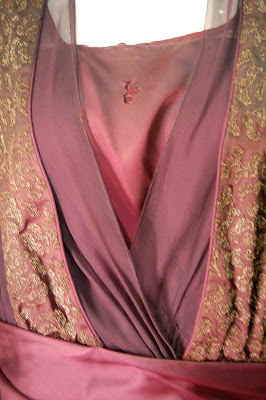 The skirt is very uniquely cut. the skirt is on the straight of grain where it connects to the back piece (at the center back seam from the left, and at the side back in the right. It is cut in the shape of a parallelogram with curved edges. the upper edge is gathered and set into the waistband. This puts the center front on the bias and creates beautiful draping on the skirt.
The skirt is very uniquely cut. the skirt is on the straight of grain where it connects to the back piece (at the center back seam from the left, and at the side back in the right. It is cut in the shape of a parallelogram with curved edges. the upper edge is gathered and set into the waistband. This puts the center front on the bias and creates beautiful draping on the skirt. There is a square cut out at the top right of the skirt and the edges are sewn together to create a peplum that fits smoothly into the skirt. The top edge of the skirt is sewn into the waistband to the center back to accentuate the peplum.
The side back of the skirt is wrapped around where the front piece is sewn in the center back and sweeps up to the side front. The draped panel is connected to the main part of the dress with a tie made of the aqua fabric, and the corner is weighted to hold it in place. The skirt is not connected in the back; rather, the pieces work together to create a wrapped look. In the center back, there is a strip of china silk to give an additional 5” of coverage. It is connected to the wrapped piece with a swing tack, and the whole skirt is hammed with a 3” piece of silk satin bias cut fabric.
 The skirt is set on a grosgrain bias tape. The under bodice, made of china silk and 2 layers of net, is connected to the top. The under bodice is flat across the top, and has a piping detail with the strings still intact to tighten the bodice around the chest. Straps made of net and a piece of cotton twill tape for support are attached to the under bodice.
The skirt is set on a grosgrain bias tape. The under bodice, made of china silk and 2 layers of net, is connected to the top. The under bodice is flat across the top, and has a piping detail with the strings still intact to tighten the bodice around the chest. Straps made of net and a piece of cotton twill tape for support are attached to the under bodice. The over bodice is made of the same aqua fabric as the skirt, and has been hand stitched on top of the bodice. Across the back, the bodice creates a smooth line across the back 2” below where the other bodice falls, and swoops up under the arms to the shoulders. The front of the bodice falls into a surplice top that is snapped in place. in the back, there is also a flat panel that connects at the shoulders and the covers the majority of the back of the bodice (except when viewing from the side.) The back piece has a fabric belt set on it to control the fullness against the waist. On the back left side there is a bow made of net along with a velvet flower.

The dress also has sleeves that are set into the shoulders. they are open across the sleeve cap, and are full underneath the arm.
The bodice has hand sewn tucks in several places, which seams to indicate that the bodice was draped and fitted on the wearer.












































